Summer active tall fescue provides autumn feed in poorly drained soils
Summer active tall fescue increases the production of high quality pasture from poorly drained soils, especially over the summer and autumn period.
Main findings
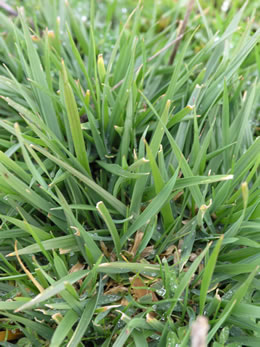 An option for filling the summer/autumn feed gap
An option for filling the summer/autumn feed gap
- Summer active tall fescue produced up to three tonnes of dry matter per hectare over April/May and 10-15 tonnes annually. It did not become dormant over the summer/autumn period, so had a longer growing season and increased feed availability at the autumn break when other perennials were slow to get moving.
Good persistence
- Summer active tall fescue sown on heavy low-lying soils persisted for more than seven years. It has deep roots that can access stored soil moisture over summer. Its persistence has also been supported by good grazing management and soil fertility.
Optimum sowing rates and sowing depth to optimise seedling density
- Under dryland conditions, summer active tall fescue sown in spring at a rate of 18-24 kg/ha and depth of 10-20 mm optimised seedling density over the following summer period. Lower sowing rates (8-16 kg/ha) resulted in sparse swards with low numbers of seedlings. Higher sowing rates (32 kg/ha) were unjustified as they provided no significant improvement in seedling density.
- A sowing depth of 10-20 mm provides a ‘best bet’ approach, with shallower sowings resulting in high rates of seed loss due to desiccation and predation on the soil surface, while deeper sowings slow down emergence and run the risk of the seedling never making it to the surface.
Optimum grazing management achieves quality and persistence
- Best quality and palatability was achieved by grazing summer active tall fescue at the three leaf stage through autumn/winter, and set stocking or grazing at the two leaf stage in spring. Long term set stocking caused poor persistence and weed invasion, especially over winter.
Read more about this research
The place and purpose of summer active fescue
Low-lying areas
Summer active tall fescue is a deep-rooted temperate perennial grass suited to heavy low lying soils. It is well adapted to growing in conditions of low oxygen availability and the salinity exchanges that occur when salts in the soil profile are mobilised by rising water, making it persistent in waterlogged conditions.
A summer-responsive, stagger-free alternative
Summer active tall fescue is closely related to perennial ryegrass but does not go dormant over summer, giving it the ability to respond to summer/autumn rain. It can access stored soil moisture due to its deep roots, which help it persist over summer and make it more tolerant to heat-waves than perennial ryegrass. Summer active fescue does not cause staggers, unlike some cultivars of ryegrass, and can therefore be used as a refuge when staggers is a problem on other parts of the farm.
Challenges with establishment and management
Summer active tall fescue’s biggest issue is its slow establishment. New cultivars selected for seedling vigour have been developed. With the correct establishment practices, grazing management and soil fertility, summer active tall fescue can effectively increase seasonal and annual pasture production from the low-lying areas of the landscape.
Management is important, especially in spring. Summer active tall fescue grows at up to 120 kg DM/ha/day in spring. Reproductive stems, which are larger and a thicker than those of perennial ryegrass, can develop and lead to a rapid decline in forage quality.. To control seedhead development, very high stocking rates are needed to keep the herbage under control.. Alternatively, the swards can be slashed to remove the reproductive stems.
What was done
Tall fescue – a component of the Triple System
[expand title=”” swaptitle=” ” tag=”h4″ elwraptag=”div” elwrapclass=”expend-collapse-wrapper”]
At the Hamilton EverGraze Proof Site, summer active tall fescue was sown on the valley floors as part of the “Triple System” (Figure 1). Other pastures in the system included semi-winter active lucerne (cv. SARDI Seven) sown on the crests, and a mid-season flowering perennial ryegrass (cv. Avalon) sown on the slopes. All pastures were sown with white clover (cv. Mink) and subterranean clovers (cv. Leura and Gosse).
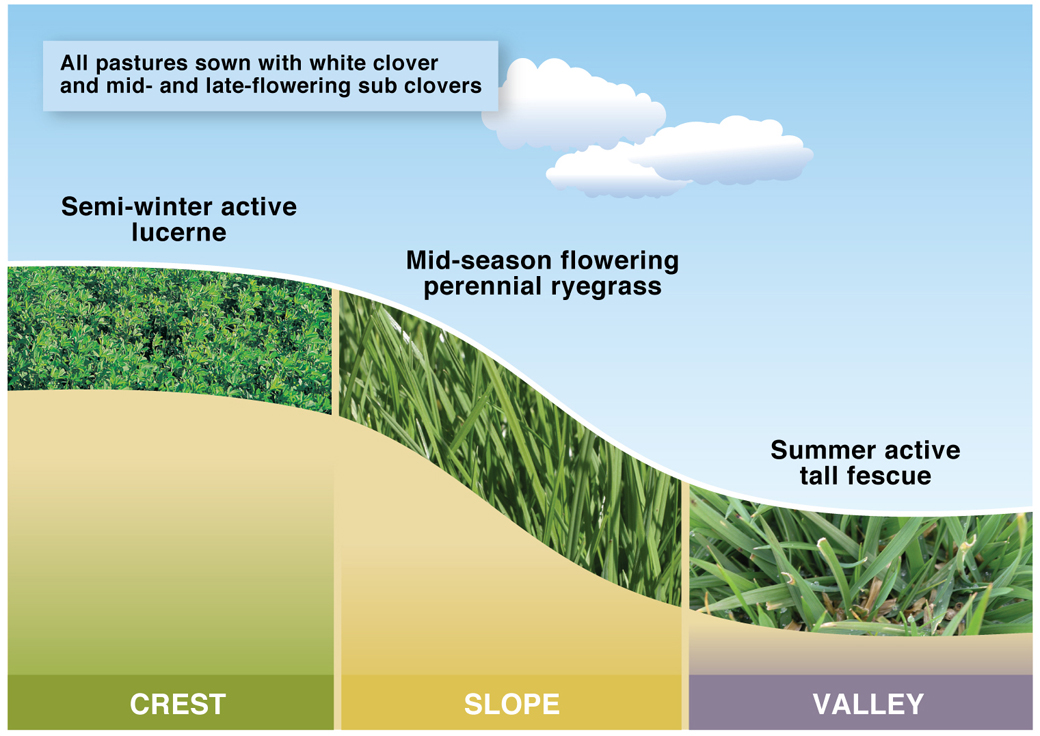
Developing establishment recommendations
Sowing depth (5, 10, 20 or 35 mm) and rate (8, 16, 24 or 32 kg/ha) were tested for their influence on seedling emergence and density of summer active tall fescue. A site was direct drilled in late October 2008, and was rolled after sowing. The soil was a grey brown clay loam with a pH(CaCl2) of 4.5, phosphorus (Olsen) of 24 mg/kg, potassium (Skene) of 340 mg/kg and sulphur (CPC) of 8 mg/kg in the top 10 cm.
Developing grazing management recommendations
The grazing management trial (on a separate site to the establishment trial) was established in spring 2004 and was subsequently over-sown with subterranean clover and white clover. Between October 2006 and October 2008, set stocking was compared to rotational grazing at three different intervals. Set stocked plots were grazed to maintain approximately 1200 kg DM/ha at all times. In the rotations, stock were grazed when the fescue recovered two, three or four leaves on each tiller, and removed when 1200 kg DM/ha remained. Plots were grazed by Merino or Coopworth ewes.
What was found?
An option for filling the summer/autumn feed gap
Summer active tall fescue was able to take advantage of heavy soils on the valley floors, utilising stored soil moisture to remain persistent, and increasing feed availability during the summer/autumn period.
Between 10-14 tonnes DM/ha were produced from the fescue pasture annually (Figure 2), and up to three tonnes DM/ha over April/May, a period when other perennials are slow to make the transition from dormancy to active growth. On the same part of the landscape, late-season flowering perennial ryegrass (Banquet) produced around 1.5 tonnes DM/ha during April/May, half the total dry matter produced by summer active tall fescue. Growth rates per day are represented in Figure 3.
Production of summer active tall fescue compared to perennial ryegrass on the valley floors
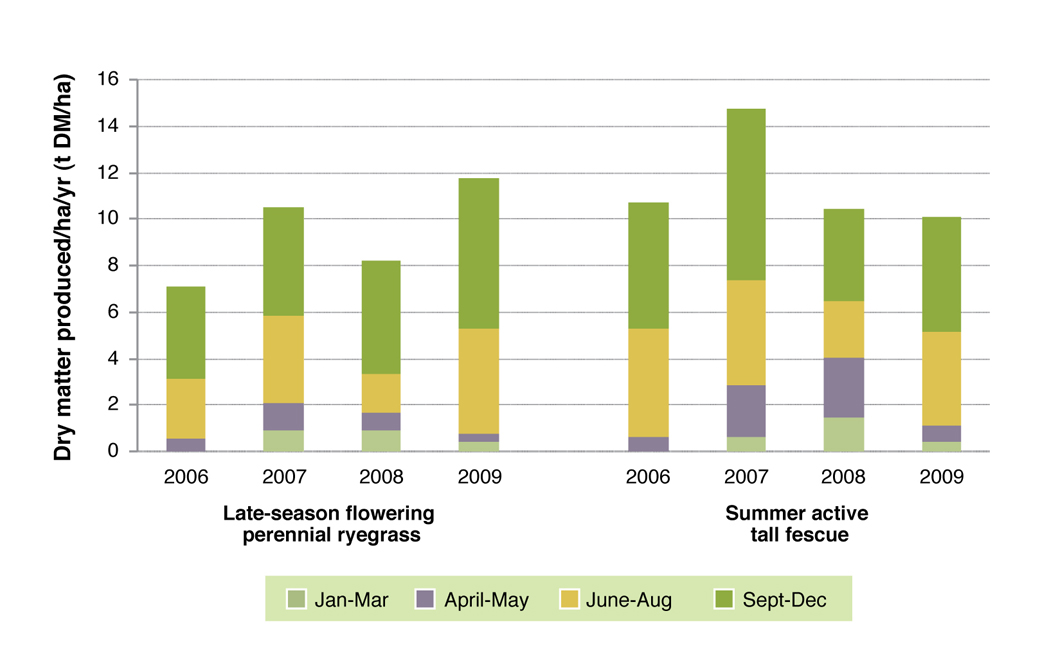
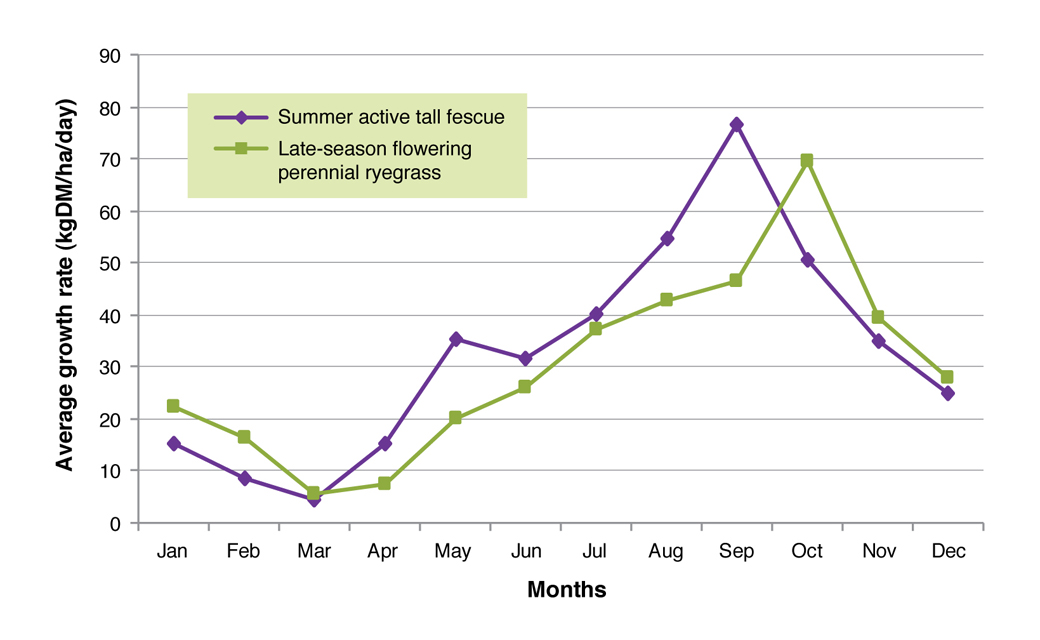
Summer growth dependent on rainfall
[expand title=”” swaptitle=” ” tag=”h4″ elwraptag=”div” elwrapclass=”expend-collapse-wrapper”]
The range of growth (minimum, average and maximum) for summer active fescue over the trial period is represented in Figure 4. The spike in the maximum growth rate curve for December and January resulted from a single late spring rainfall event (100 mm in early November 2007). Although this demonstrates that summer active tall fescue can respond to summer rains, growth rates from January through to March were consistently lower than the other summer active species, such as lucerne, chicory, and even late-season flowering perennial ryegrass.
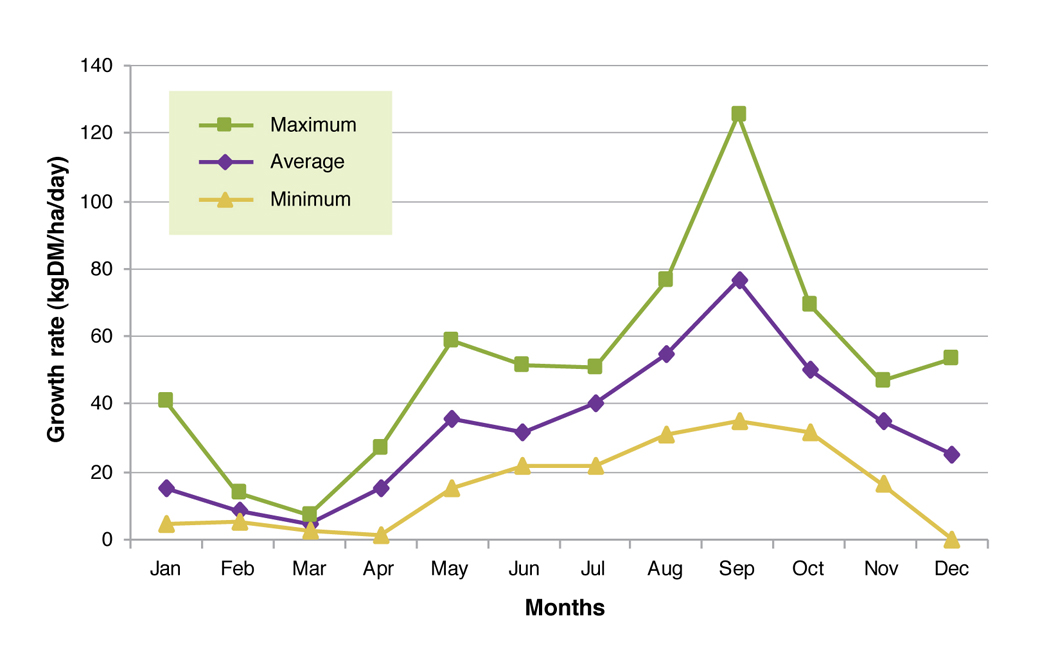
Persistent in heavy, waterlogged soils
At Hamilton, the summer active tall fescue pastures sown in spring 2004 persisted for more than seven years (Figure 5) as a result of its deep root system enabling access to stored soil water, combined with good soil and grazing management. During the experiment, the summer active tall fescue tolerated waterlogging on the valley floors, being under water for up to seven days in 2007(see below).
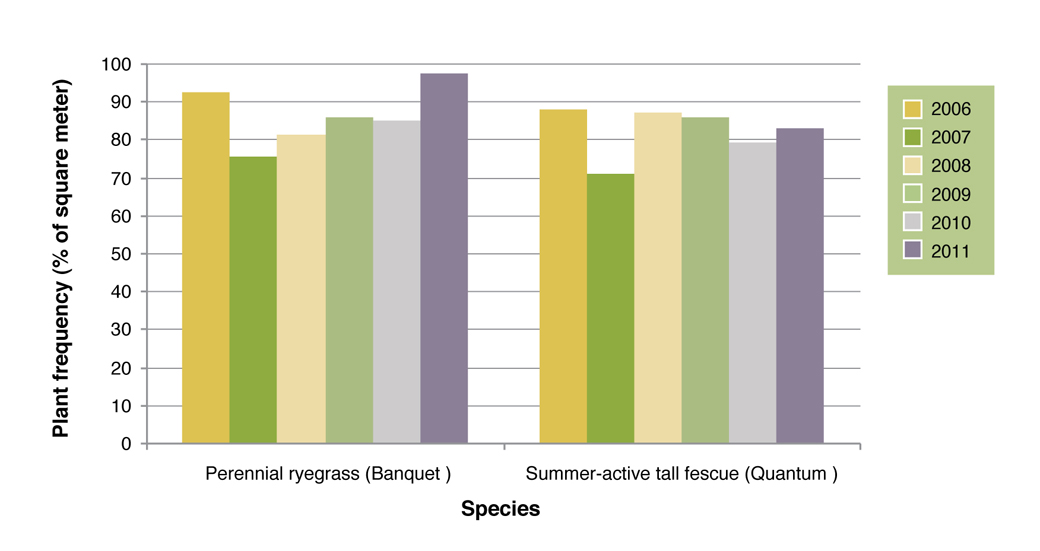
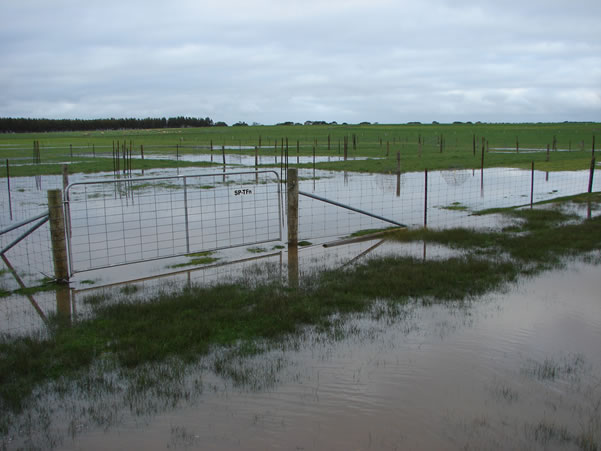
Sow 18-24 kg/ha at 10-20 mm in spring
To achieve a dense sward, optimum sowing depth was 10-20 mm, with a sowing rate of 18-24 kg/ha in spring. Sowing deeper than this may result in seedling death due to the seed depleting its endosperm energy reserves before it penetrates the soil surface. Sowing too shallow, however, places the seed in danger of desiccation (drying out) on the soil surface, especially under dryland conditions. Sowing rates of below 18 kg/ha are likely to result in swards lacking density due to insufficient seedling establishment. There is little merit in sowing at rates above 24 kg/ha, however, due to intra-seedling competition for moisture and nutrients resulting in seedling death and seed wastage.
Graze at the three-leaf stage for maximum production, quality and utilisation
Grazing summer active tall fescue when tillers reached the three-leaf stage maximised pasture growth rate and ensured optimum utilisation. Summer active tall fescue produces four leaves per tiller (unlike ryegrass which has three) but quality and quantity were penalised if left to reach the four-leaf stage. When set stocked or grazed at shorter intervals (two leaves) through autumn and winter, there was a higher weed burden and persistence was compromised.
Set stock or graze at the two-leaf stage in spring
Summer active tall fescue had excessive spring growth rates – higher than perennial ryegrass. When grazed at the three or four leaf-stage during this time, quality quickly declined as it moved into the reproductive phase (Table 1). Set stocking (to 1200 kg/ha) or maintaining a very fast rotation (at the two-leaf stage) tended to slow the growth rate, helping it to remain vegetative for longer, and significantly increasing feed quality.
Table 1. Nutritive value and growth rate of summer active tall fescue grazed under four different grazing strategies in spring 2008
| Grazing strategy | Growth rate (kgDM/h/day) | Protein (% DM) | Digestibility (% DM) | Fibre (% DM) |
|
Set stocked |
60 |
24 |
77 |
37 |
|
2-leaf |
64 |
24 |
76 |
40 |
|
3-leaf |
86 |
18 |
68 |
48 |
|
4-leaf |
72 |
10 |
59 |
58 |
Research in action
John and Maurine Fish established summer active fescue on waterlogged clays at Mt Wallace near Ballarat where they hosted an EverGraze Supporting Site from 2009-2012. They found that the summer active fescue persisted in heavy water-logged conditions, and was able to carry 15 DSE/ha. John said that pasture production was actually higher than represented by the stocking rate, as a result of having to restrict grazing to the summer months due to waterlogging and pugging. The biggest challenges faced by John were utilising the high spring growth, especially when the paddocks couldn’t be grazed for much of winter due to waterlogging. The under-grazing also made it difficult to maintain clover in the stand which declined to 5% of total pasture composition. John and Maurine also established lucerne and winter active tall fescue at their site as part of a system. Click here to read the full case study.
What it all means
Summer active tall fescue is a stagger-free, summer-responsive alternative to perennial ryegrass. It is persistent on heavy, waterlogged flats which may otherwise be underutilised. Its biggest strength in a grazing system is the quality feed produced in autumn when other species are slow to get going. Establishment issues can be overcome by sowing at the correct rate and depth in spring, and persistence and production are optimised when a rotation (grazing at the three-leaf stage) is implemented through autumn and winter.
Heavy grazing through the spring period helps overcome issues with the quality of summer active tall fescue. However, this means that tall fescue should be sown as a component of a system with species that will hold their quality for longer (e.g. lucerne), and livestock systems should be managed so that peak stocking rate is reached in spring.
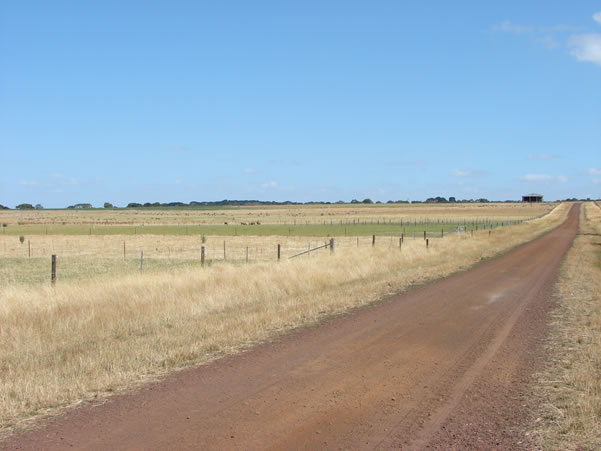
Acknowledgements
EverGraze is a Future Farm Industries CRC research and delivery partnership. The Hamilton EverGraze Proof Site team was led by Dr. Ralph Behrendt and consisted of scientists and technical staff from Agriculture Victoria. An enthusiastic Regional Advisory Group consisting of farmers, consultants extension officers and CMA staff provided significant input into the direction, management practices and interpretation of outcomes from the experiment and modelling to make them relevant to farmers. The summer active tall fescue studies were the subject of a PhD conducted by Margaret Raeside.
Further Information
- EverGraze Action – Growing and using summer active Tall Fescue
- Pastures for place and purpose in bent grass country – John and Maureen Fish, Mt Wallace, South West Victoria
- Raeside MC, Friend MA, Behrendt R, Lawson AR, Clark SG. Evaluation of tall fescue (Festuca arundinacea) as a forage for sheep in the temperate high-rainfall zone of south-eastern Australia. Grass and Forage Science
- Raeside MC, Friend MA, Behrendt R, Lawson AR, Clark SG. Tall fescue establishment and management in south west Victoria. New Zealand Journal of Agricultural Research 55, 31-46.
- Raeside MC, Friend MA, Behrendt R, Lawson AR, Clark SG (2012) A review of summer-active tall fescue use and management in Australia’s high-rainfall zone, New Zealand Journal of Agricultural Research, 55, 393-411.
- Fribourg HA, Hannaway DB, West CP, (eds) (2009) ‘Tall Fescue for the Twenty-first Century. Agronomy Monograph No. 53.’ (American Society of Agronomy, Inc, Crop Science Society of America, Inc and Soil Science Society of America, Inc: Madison, Wisconsin, USA).

